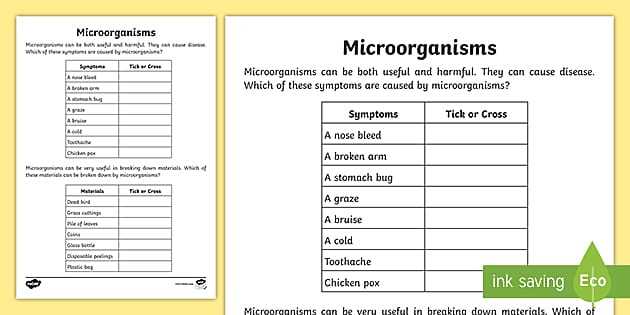
Understanding the fascinating world of single-celled organisms is a key part of studying biology. These microscopic creatures play significant roles in various ecological processes, from nutrient cycling to disease transmission. Their complexity and diversity make them an important subject of research and observation.
In this section, we delve into the essential concepts and classifications that define these organisms. By examining their structure, behavior, and lifecycle, we gain insight into how they adapt to different environments. Whether living in water, soil, or inside a host, these organisms exhibit a variety of survival strategies that contribute to their success.
Identifying these organisms involves understanding their unique characteristics, which set them apart from other life forms. Their ability to reproduce rapidly and survive in harsh conditions makes them both resilient and resourceful. Gaining a deeper appreciation for these organisms enhances our understanding of the natural world and the vital roles they play in maintaining ecological balance.
Understanding Microorganism Classification
The classification of microscopic organisms is fundamental in biology, as it helps organize these life forms into categories based on shared characteristics. This system allows scientists to study the diversity of life more effectively and understand the relationships between different groups. In this section, we explore how these organisms are grouped and categorized based on their physical traits, behaviors, and ecological roles.
Key Features for Classification
Organisms of this category are typically classified based on several distinct features, including their mode of movement, type of reproduction, and structure. These characteristics are used to create broader categories, which are then subdivided into more specific types. Understanding these differences is essential for identifying and distinguishing between the various forms of life in this group.
| Category | Movement Type | Reproduction | Habitat |
|---|---|---|---|
| Amoeboids | Pseudopodia | Asexual | Freshwater, soil |
| Ciliates | Cilia | Asexual, Sexual | Water environments |
| Flagellates | Flagella | Asexual | Various environments |
| Apicomplexans | Non-motile | Sexual, Asexual | Parasitic |
Role of Classification in Study
Classifying these organisms helps researchers identify patterns and make connections between different species. It also plays a crucial role in medical research, as understanding the traits of harmful species can assist in developing treatments for diseases. By categorizing these microscopic life forms, scientists gain a deeper understanding of how they interact with their environment and each other.
Identifying Different Types of Single-Celled Organisms
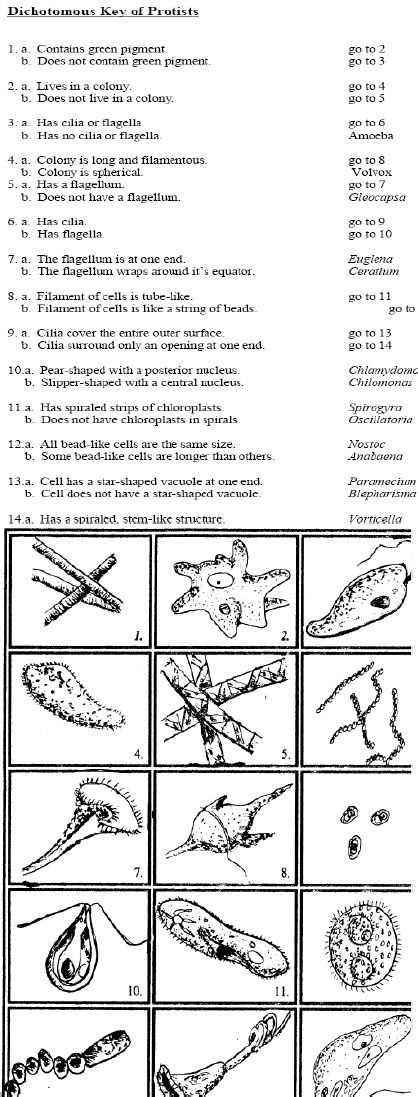
Recognizing the various types of microscopic organisms is essential for understanding their behavior, habitat, and role in ecosystems. These organisms exhibit a wide range of structures, movements, and survival strategies, making them diverse in appearance and function. Identifying them requires an understanding of their key characteristics and the methods they use to interact with their environment.
Characteristics for Identification
The primary way to classify these organisms is by examining their unique features, such as their method of locomotion, shape, and means of obtaining nutrients. Some are characterized by their ability to move using flagella, cilia, or pseudopodia, while others may be non-motile. These distinctions provide a solid foundation for categorizing them into specific groups.
Common Types and Their Traits
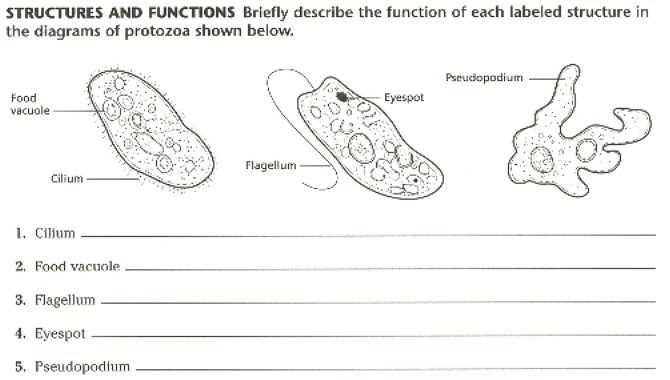
Each group of organisms has distinct traits that make identification easier. Some of the most common types are:
| Type | Key Feature | Movement Method |
|---|---|---|
| Amoeboids | Flexible, irregular shape | Using pseudopodia (false feet) |
| Ciliates | Cilia covering body | Movement through coordinated cilia |
| Flagellates | Flagellum(s) present | Movement using whip-like flagella |
| Apicomplexans | Non-motile in mature stage | Requires host for movement |
By carefully observing these characteristics, scientists and researchers can quickly identify the type of organism they are studying and determine its potential behavior and role in its ecosystem.
Life Cycle of Single-Celled Organisms

The life cycle of these microscopic organisms involves a series of stages that ensure their survival and reproduction. Understanding these stages helps to explain how these organisms grow, develop, and adapt to various environments. Each stage of their life cycle is crucial for maintaining their populations and facilitating their roles in ecosystems.
Stages of Development
Typically, the life cycle begins with a reproductive phase, where the organism undergoes a process of cell division. Depending on the species, this division may be asexual, producing genetically identical offspring, or sexual, involving the combination of genetic material from two individuals. After this initial stage, the organism enters a growth phase, where it matures and increases in size.
Transformation and Dormancy
As the organism continues to develop, it may encounter adverse conditions that trigger a transition into a dormant or cyst form. This stage allows it to survive harsh environments, such as extreme temperature changes or a lack of nutrients. When conditions improve, the organism can reactivate and continue its life cycle, returning to a more active state.
Each phase of the life cycle plays a key role in ensuring the organism’s ability to thrive in diverse environments, making these processes vital for understanding their behavior and impact on their surroundings.
Stages in Single-Celled Organism Development
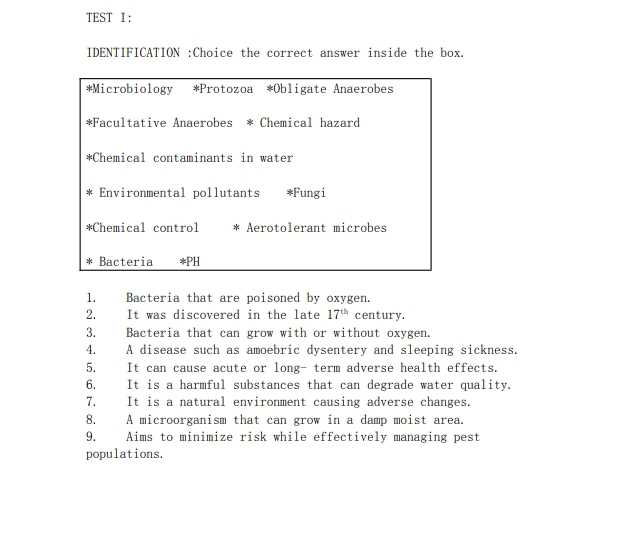
The development of single-celled organisms involves several key stages, each crucial for their growth, reproduction, and survival. These stages can vary slightly depending on the organism’s species, but generally follow a predictable pattern that ensures the organism’s continuity through generations. By studying these stages, scientists can better understand how these organisms adapt to their environments and proliferate.
Initial Stage: Zygote Formation
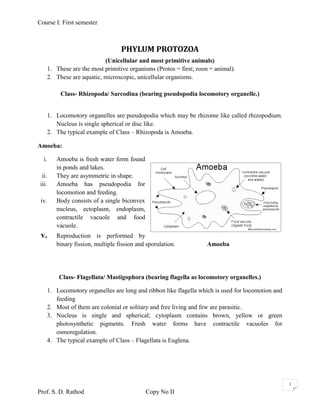
The development process typically begins when two parent cells combine their genetic material, forming a zygote. This initial stage marks the start of the organism’s life cycle and sets the stage for subsequent stages of division and differentiation.
Growth and Division Phases
After the zygote forms, the organism undergoes several stages of cell division and growth. These stages include:
- Binary Fission: The organism divides into two identical daughter cells, ensuring a rapid increase in population.
- Schizogony: A process where the organism undergoes multiple rounds of division before the cell splits into numerous offspring, often seen in parasitic species.
- Syngamy: In some species, sexual reproduction occurs through the fusion of two specialized reproductive cells, leading to genetic diversity.
Transformation and Dormant Stages
As conditions change, many organisms will enter a dormant stage, where they form cysts to withstand unfavorable environments such as extreme temperatures or lack of nutrients. These cysts allow the organism to survive until conditions improve.
- Cyst Formation: The organism forms a protective outer layer to shield itself from environmental stressors.
- Reactivation: When the environment becomes more favorable, the cyst breaks open, and the organism returns to its active, reproductive state.
Understanding these stages highlights the adaptability and resilience of these organisms, allowing them to thrive in a variety of ecological niches.
Single-Celled Organisms and Human Diseases
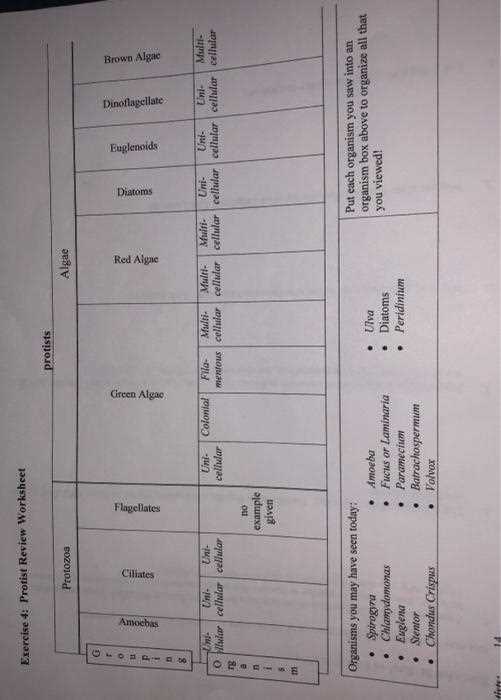
Certain microscopic organisms play a significant role in causing a variety of diseases in humans. These organisms, often transmitted through contaminated water, food, or vector organisms, can lead to a range of health issues, from mild infections to life-threatening conditions. Understanding how these organisms interact with the human body is crucial for developing effective treatments and preventive measures.
Many of these microorganisms are parasitic, relying on the human body for nutrients and shelter. Once inside the host, they can affect different organs and systems, often leading to inflammation, tissue damage, or other complications. In some cases, these organisms can also spread to other individuals, further complicating disease control.
Common Diseases Caused by Single-Celled Organisms
These microscopic organisms are responsible for several well-known diseases, which include:
- Malaria: Caused by parasites transmitted through the bite of infected mosquitoes. It primarily affects the liver and red blood cells, leading to symptoms such as fever, chills, and anemia.
- Amebiasis: Caused by the amoeba *Entamoeba histolytica*, leading to gastrointestinal symptoms like diarrhea and stomach cramps.
- Leishmaniasis: A disease caused by parasites spread through sandfly bites, leading to skin ulcers or internal organ damage.
- Sleeping Sickness: Caused by the parasite *Trypanosoma brucei*, transmitted by the tsetse fly, leading to neurological symptoms like fatigue, confusion, and in severe cases, coma.
Prevention and Treatment
Preventing diseases caused by these microorganisms requires a combination of good hygiene practices, safe food and water consumption, and vector control methods such as insecticides and bed nets. In many cases, medications are available to treat infections, but resistance can develop, making early detection and proper management essential.
Understanding the role of these organisms in human diseases is vital for both prevention and treatment strategies, as they continue to pose health risks in many regions worldwide.
Impact of Single-Celled Organisms on Health
Single-celled organisms can have a profound effect on human health, particularly when they become pathogenic. These microscopic life forms are capable of invading the human body, causing a range of diseases that can lead to serious health complications. Understanding their impact on health is crucial for both prevention and treatment of the diseases they cause.
Health Complications
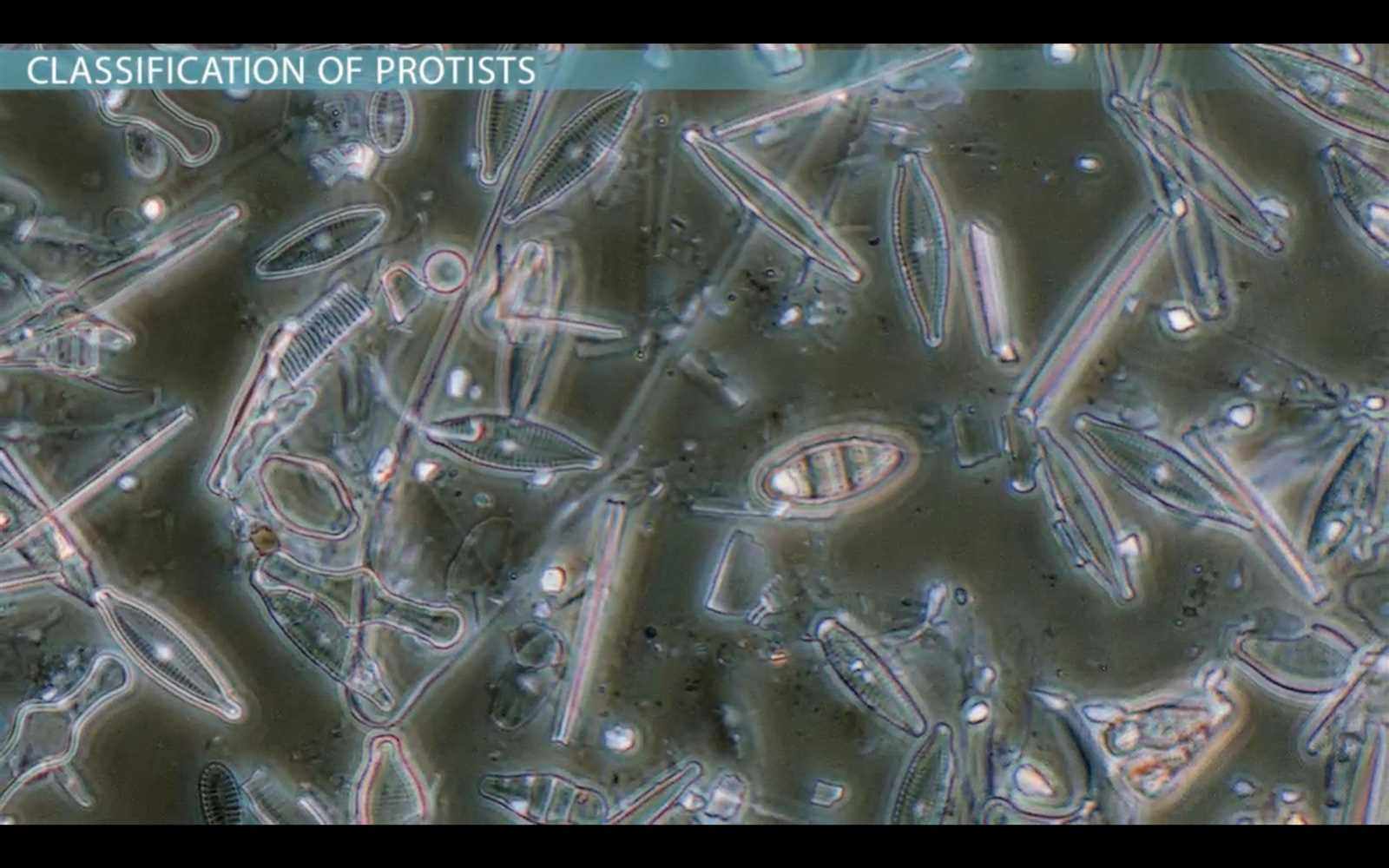
When these organisms infect humans, they can affect various parts of the body, from the gastrointestinal tract to the nervous system. Some of the most common health complications include:
- Infections: These organisms can cause chronic or acute infections, leading to symptoms like diarrhea, fever, and fatigue.
- Immune System Damage: Prolonged infections can weaken the immune system, making the body more susceptible to other infections or diseases.
- Organ Damage: Some species can infect vital organs, such as the liver, brain, or heart, leading to life-threatening conditions like encephalitis or organ failure.
Prevention and Control
Preventing the spread of these harmful microorganisms requires both public health efforts and personal hygiene practices. Safe drinking water, proper sanitation, and the use of insect repellents are key factors in reducing the risk of infection. In addition, treatments such as antiparasitic medications can be used to target the organisms directly, helping to mitigate their harmful effects on human health.
By recognizing the potential health risks associated with these organisms and taking proactive measures, it is possible to reduce their impact on individuals and communities.
Key Characteristics of Single-Celled Organisms
Single-celled organisms are diverse and fascinating, with a variety of features that enable them to survive and thrive in different environments. These organisms, though microscopic, display remarkable adaptability, often exhibiting behaviors and structures that allow them to interact with their surroundings in complex ways. Understanding their defining characteristics is crucial to identifying and studying their biology.
Structural Features
One of the most distinctive characteristics of these organisms is their simple structure. Despite lacking the complexity of multicellular life, they possess specialized structures that allow them to perform necessary functions. Key structural features include:
- Plasma Membrane: A flexible membrane that regulates the entry and exit of materials, providing protection and maintaining homeostasis.
- Organelles: Specialized structures within the cell that perform various functions, such as energy production, waste removal, and reproduction.
- Cytoplasm: The gel-like substance that fills the cell, providing a medium for biochemical reactions and structural support.
Modes of Locomotion and Feeding
Another important characteristic is how these organisms move and obtain nutrition. Depending on the species, they may use different methods to navigate their environment and acquire food:
- Motility: Some organisms use flagella, cilia, or pseudopodia to move through their environment, allowing them to explore and find resources.
- Feeding: These organisms often exhibit heterotrophic behavior, absorbing nutrients from other living organisms or organic matter through processes like phagocytosis or absorption.
These features enable single-celled organisms to thrive in various environments, making them important players in both ecological systems and human health.
Protozoa Habitat and Environment
These microscopic organisms thrive in a wide variety of environments, adapting to conditions that range from freshwater to soil and even inside the bodies of animals. Their habitats offer diverse conditions, including the presence of water, temperature fluctuations, and varying levels of nutrients. Understanding these environments is key to comprehending how these organisms survive and reproduce in the wild.
Aquatic Ecosystems
Many of these organisms are found in aquatic habitats, whether in ponds, lakes, or oceans. They often inhabit shallow areas where organic matter accumulates, providing them with an abundant food supply. Water quality, temperature, and oxygen levels in these environments play a critical role in the distribution of these microorganisms, influencing their population density and behavior.
In addition to aquatic systems, certain species are adapted to live in terrestrial environments or inside the digestive systems of animals. Soil provides a stable medium for some forms to thrive, while others are parasitic, depending on their hosts for sustenance and survival. These organisms can withstand extreme conditions, such as dehydration or the absence of food, by entering a dormant state until more favorable conditions arise.
Where Protozoa Live and Thrive
These microscopic organisms are incredibly versatile, thriving in a variety of environments that offer the right conditions for their survival. From freshwater bodies to the bodies of animals, their adaptability allows them to inhabit diverse habitats, each with unique characteristics. The factors that determine their presence include temperature, water quality, and the availability of organic matter.
| Environment Type | Conditions for Survival | Example Locations |
|---|---|---|
| Freshwater | Abundant nutrients, stable water temperature, low salinity | Lakes, ponds, streams |
| Marine | Higher salinity, varying water temperatures, rich in organic material | Oceans, coastal areas |
| Soil | Moisture availability, organic matter for nourishment | Forest floors, damp soil |
| Inside Hosts | Warmth, nutrient-rich environment, protection from external factors | Intestinal tracts, other body cavities of animals |
Reproduction Methods in Protozoa
Reproduction in these single-celled organisms is a dynamic process that ensures their survival and propagation across various environments. These organisms utilize different mechanisms to reproduce, depending on environmental conditions and species-specific traits. Their methods can be asexual or sexual, each playing a critical role in the continuation of the species.
- Asexual Reproduction: This is the most common form of reproduction, where organisms duplicate their genetic material and divide into two or more identical offspring.
- Binary Fission: A form of asexual reproduction where the organism divides into two equal parts, each becoming a new organism.
- Budding: In this method, a small outgrowth from the parent organism develops into a new individual. The offspring may remain attached or separate eventually.
- Multiple Fission: This process involves the division of the organism into several smaller offspring simultaneously, often seen in larger species.
Sexual Reproduction
Some species also engage in sexual reproduction, which involves the fusion of gametes from two different individuals to create a genetically unique offspring. This method contributes to genetic diversity, which can enhance adaptability to changing environments.
- Conjugation: Two organisms exchange genetic material, leading to new combinations of genes. This is common in certain species that need to adapt quickly to environmental changes.
- Syngamy: The process where two specialized gametes fuse to form a zygote, starting the development of a new organism.
Sexual and Asexual Reproduction
Reproduction in these microorganisms can occur through two distinct methods: asexual and sexual. Asexual reproduction allows for rapid population growth by producing offspring identical to the parent organism. In contrast, sexual reproduction promotes genetic diversity, which can increase adaptability to environmental changes. Both methods play vital roles in maintaining and propagating the species.
| Reproduction Type | Process Description | Advantages |
|---|---|---|
| Asexual | Offspring are genetically identical to the parent, often produced through processes like binary fission or budding. | Rapid population increase, no need for mates, energy-efficient. |
| Sexual | Involves the fusion of gametes from two individuals, resulting in offspring with genetic variation. | Genetic diversity, adaptability to changing environments, increased survival in variable conditions. |
Importance of Protozoa in Ecosystems

These microscopic organisms play a crucial role in maintaining the balance of ecosystems by contributing to various environmental processes. They help regulate populations of bacteria and other microorganisms, thus shaping the dynamics of both aquatic and terrestrial habitats. Additionally, their interactions with other species create intricate food webs, supporting the overall health and stability of ecosystems.
Contribution to Nutrient Cycling
By feeding on bacteria, algae, and other small organisms, these organisms help break down organic material, recycling essential nutrients back into the environment. This process ensures that the ecosystem remains nutrient-rich, supporting the growth of plants and other primary producers.
Role in Food Webs
Serving as a food source for larger organisms, such as small invertebrates and fish, these microorganisms occupy an important position in the food chain. Their abundance and diversity allow them to support a wide range of species, contributing to biodiversity and ecosystem resilience.
Roles of Protozoa in Nature
These microscopic organisms perform vital tasks within natural environments, ensuring ecological balance and supporting biodiversity. They are integral to various ecological processes such as nutrient cycling, decomposition, and regulating the populations of other microorganisms. Their interactions with plants, animals, and other microorganisms create complex relationships that sustain ecosystems.
- Nutrient Recycling: By consuming bacteria and decaying organic matter, these organisms help break down complex nutrients, returning essential elements like nitrogen and phosphorus to the soil and water. This recycling process promotes healthy plant growth and supports the entire food web.
- Controlling Microbial Populations: They regulate bacterial populations by feeding on them, which helps prevent the overgrowth of harmful microorganisms that could disrupt the balance of the ecosystem.
- Foundation of Food Chains: As prey for larger organisms, they form a crucial part of the food chain, supporting the survival of various species, from small aquatic invertebrates to fish and other predators.
- Decomposition of Organic Matter: These organisms aid in the decomposition of dead organisms, breaking down organic materials into simpler compounds that enrich the soil, promoting plant growth, and maintaining ecosystem health.
Protozoan Movement Techniques
These microscopic organisms utilize various methods to navigate through their environments, each suited to their specific needs and habitat. Movement is crucial for their survival, as it allows them to find food, escape predators, and interact with other organisms. The mechanisms they use for locomotion include both active and passive methods, which vary in complexity.
One common technique involves the use of flagella, long, whip-like structures that propel the organism forward. Another method is the use of cilia, tiny hair-like extensions that beat rhythmically to move the organism through liquids. Some species rely on pseudopodia, extensions of their cell membrane that allow them to “crawl” or engulf food, a process known as amoeboid movement. Each of these techniques enables the organism to thrive in its environment, whether in water, soil, or inside a host organism.
How Protozoa Move and Swim
These tiny organisms exhibit remarkable locomotion abilities that allow them to navigate various environments, whether it’s moving through water or crawling along surfaces. Their movement techniques are diverse and highly specialized, enabling them to adapt to their surroundings and perform necessary functions such as feeding, reproduction, and avoiding predators.
| Movement Type | Description | Key Features |
|---|---|---|
| Flagellar Movement | Utilizes long, whip-like structures to propel the organism forward in a swimming motion. | Flagella act as motors, generating propulsion in aquatic environments. |
| Ciliary Movement | Small, hair-like structures beat in rhythmic patterns to move the organism through water. | Cilia create a coordinated wave-like motion, often covering the surface of the organism. |
| Amoeboid Movement | Involves the extension and retraction of the cell membrane to crawl or “flow” across surfaces. | Uses pseudopodia, or temporary projections of the cell, to move and engulf food. |
Differences Between Protozoa and Bacteria
Although both microorganisms play significant roles in ecosystems, they differ vastly in their structure, function, and lifestyle. Understanding these differences is crucial for distinguishing between these two types of organisms and appreciating their individual contributions to the environment and health.
- Cell Structure: One of the primary distinctions is that bacteria are unicellular organisms without a defined nucleus, while other microorganisms possess a more complex cellular structure with a defined nucleus and various organelles.
- Size: Bacteria are generally smaller than their counterparts, often measuring just a few micrometers in diameter, while other microorganisms tend to be larger and can be seen more easily under a microscope.
- Reproduction: Bacteria reproduce asexually through binary fission, a simple division process. In contrast, other microorganisms can reproduce both sexually and asexually, often involving more complex mechanisms.
- Mobility: While both types can move, the methods vary. Bacteria may use flagella or pili for movement, while more complex microorganisms may utilize cilia, flagella, or pseudopodia for mobility.
- Metabolism: Bacteria can survive in a wide range of environments and may be either autotrophic or heterotrophic. In comparison, other microorganisms generally require more specific environmental conditions and have more complex metabolic needs.
Distinguishing Protozoa from Other Microbes
Microorganisms are a diverse group of tiny organisms that can be found in nearly every environment. Among them, some are single-celled eukaryotes, while others are prokaryotes with simpler cellular structures. Recognizing the differences between these groups is essential for understanding their roles in ecosystems and their unique characteristics.
Key Characteristics of Eukaryotic Microorganisms
Unlike prokaryotes, which lack a defined nucleus, these organisms are eukaryotic, meaning they possess a well-organized nucleus and a variety of organelles that carry out specialized functions. This structural complexity sets them apart from bacteria and other simpler microbes. Additionally, their larger size and ability to move actively distinguish them from smaller, less mobile organisms.
Differences in Reproduction and Metabolism
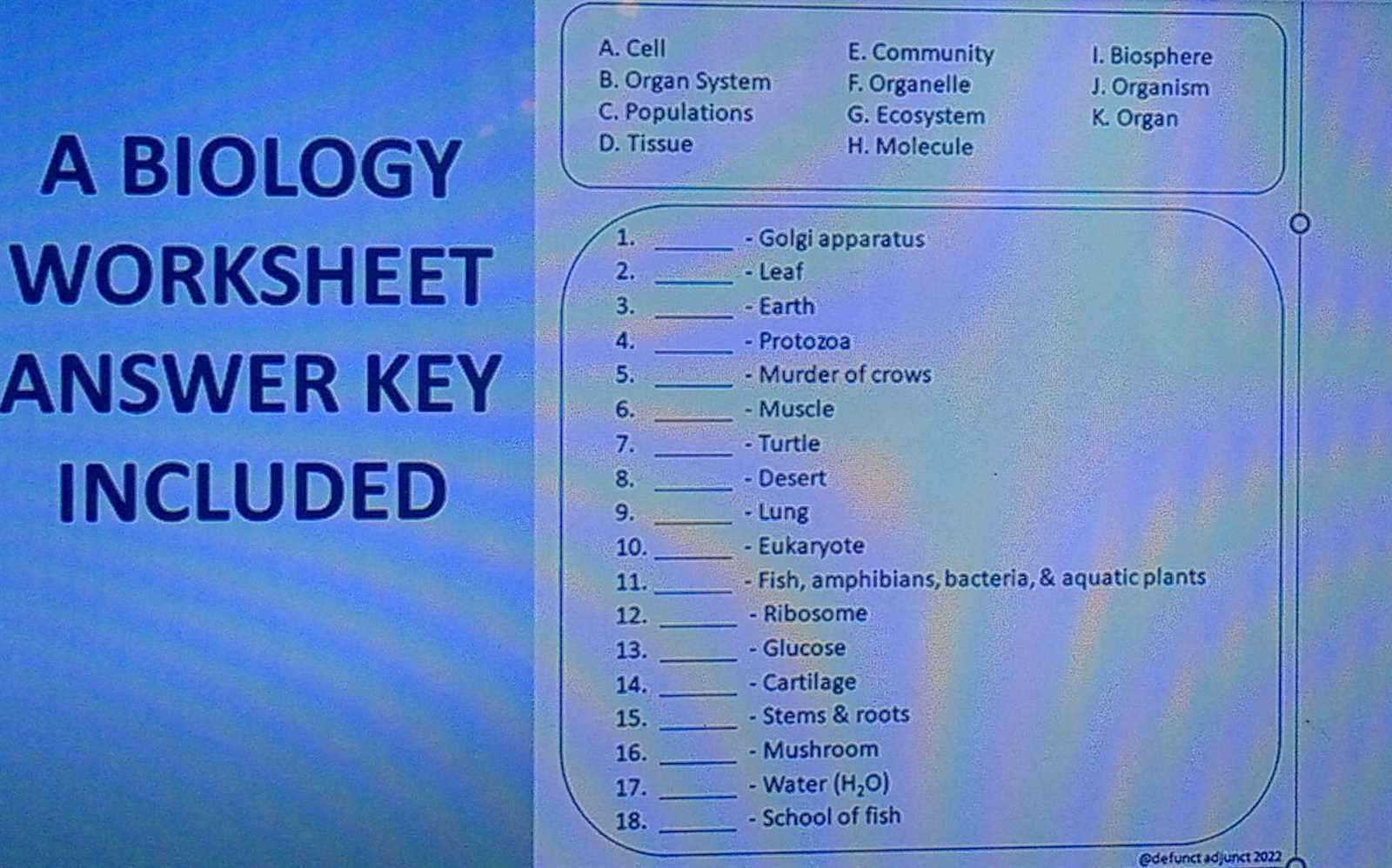
Reproduction in these organisms can occur both sexually and asexually, offering greater genetic diversity compared to prokaryotes, which typically reproduce by binary fission. Metabolic processes also vary widely, with some of these organisms exhibiting advanced methods of obtaining energy through absorption, ingestion, or photosynthesis, unlike the more basic methods employed by simpler microbes.
- Complex Cellular Structure: These organisms have organelles such as mitochondria and a defined nucleus, unlike bacteria, which lack these structures.
- Mobility: They often possess cilia, flagella, or pseudopodia for movement, while many bacteria rely solely on flagella or pili.
- Reproduction: Capable of both sexual and asexual reproduction, providing increased genetic variation, whereas bacteria reproduce primarily through binary fission.